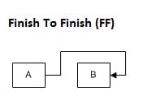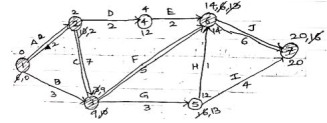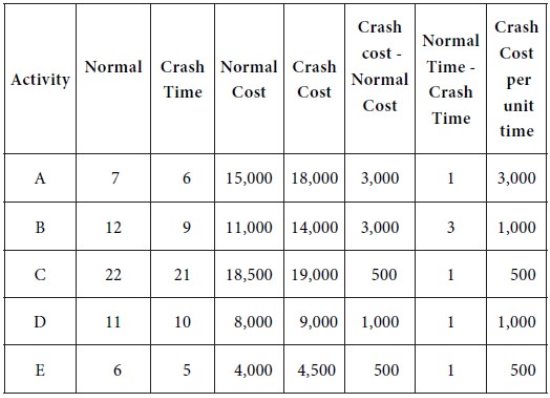|
|
|
|
|
|
|
|
|
|
A6) Forward pass method (For Earliest event time):
Based on the fixed occurrence time of the initial network event, the forward pass computation yields the earliest start and earliest finish times for each activity and indirectly the earliest expected occurrence time for each event.This consists of the following steps:2. Calculate the earliest start time for each activity that begins at the event i. This is equal to the earliest occurrence time of event i (Tail event) i.e., ESij = Ei for all activity (i, j) starting from the event i.
3. Calculate the earliest finish time of each activity (I, j) which is the earliest start time of the activity plus the duration of the activity, i.e.
EFij = ESij + tij= Ei + tij 4. Calculate the earliest occurrence time for event j (J > i) which is the maximum of the earliest finish times of all activities ending into that event, i.e.Ej = Maximum (ESij + tij)= Max [Ei + tij]The computed values are put into the lower-left portion of each event.Backward pass method (For latest allowable time):In this method, the calculation begins from the last event L.The various steps are as follows:1. Set the latest occurrence time of the last event L which is equal to the earliest occurrence time of that event obtained from the forward pass method.i.e., Assume L = E for ending event.2. Latest finish time for activity (i,j) equal to the latest event time of event j, i.e., LFij = Li
3. The latest starting time of activity (i,j) is the latest completion time of (i,j) minus the activity time i.e.LSij = LFij – tij= Li – tij4. Latest event time for the event i is the minimum of the latest start time of all activities originating from that event.Thus,Li = Minimum (LSij)= Min (LFij – tij)= Min (Lj – Lij)The computed values are put into the lower right portion of each event. Q7) Define the following terms: EST, EFT, LST, LFT, Free float, Independent float, and Interference float. A7) The terms can be defines as follows:
| A | B | C | D | E | F | G | H | I | J |
Activity | 1-2 | 1-3 | 2-3 | 2-4 | 4-6 | 3-6 | 3-5 | 5-6 | 5-7 | 6-7 |
Duration | 2 | 3 | 7 | 2 | 2 | 5 | 3 | 1 | 4 | 6 |
Activity | Duration | EST | EFT | LST | LFT | T.F | F.F |
A(1-2) | 2 | 0 | 2 | 0 | 2 | 0 | 0 |
B(1-3) | 3 | 0 | 3 | 6 | 9 | 6 | 6 |
C(2-3) | 7 | 2 | 9 | 2 | 9 | 0 | 0 |
D(2-4) | 2 | 2 | 4 | 10 | 12 | 8 | 0 |
E(4-6) | 2 | 4 | 6 | 12 | 14 | 8 | 8 |
F(3-6) | 5 | 9 | 14 | 9 | 14 | 0 | 0 |
G(3-5) | 3 | 9 | 12 | 10 | 13 | 1 | 0 |
H(5-6) | 1 | 12 | 13 | 13 | 14 | 1 | 1 |
I(5-7) | 4 | 12 | 16 | 16 | 20 | 4 | 4 |
J(6-7) | 6 | 14 | 20 | 14 | 20 | 0 | 0 |
|
|
Q10) What are the steps in crashing a project?
A10) The process of Project Crashing is as follows:1. Compute the crash cost per
period*. If crash costs are linear over time: 𝐶𝑟𝑎𝑠ℎ 𝐶𝑜𝑠𝑡 𝑃𝑒𝑟 𝑃𝑒𝑟𝑖𝑜𝑑 = 𝐶𝑟𝑎𝑠ℎ 𝐶𝑜𝑠𝑡 − 𝑁𝑜𝑟𝑚𝑎𝑙 𝐶𝑜𝑠𝑡 𝑁𝑜𝑟𝑚𝑎𝑙 𝑇𝑖𝑚𝑒 − 𝐶𝑟𝑎𝑠ℎ 𝑇𝑖𝑚𝑒
2. Find the critical path.
• Identify the critical activities using current activity times
3. Find the critical path activity with the lowest crash cost and crash this activity by 1-time unit
• E.g. Crash by 1 day, week, month
• Examine only critical path activities that can be crashed (i.e. max crash possible > 0)
• If there are multiple critical paths, crash multiple activities at the same time or crash one activity that is common to all the critical paths. Choose the strategy that gives the lowest overall cost.
4. Update all activity times. If the desired due date has been reached, stop. If not, return to Step 2.
Q11) The management of a company is interested in crashing the following project by spending an additional amount not exceeding Rs. 2,000. Suggest how this can be accomplished.
|
A11) We have the following network diagram for the given project with normal costs:
|
|
The crash cost per unit time for the activities in the project is provided in the following table.
|
Rs. 3,000 for A; Rs. 1,000 for B; Rs. 1,000 for D; Rs. 500 for E.
The least among them is Rs. 500. So we have to choose activity E for crashing. We reduce the time of E by one week by spending an extra amount of Rs. 500. After this step, we have the following network with the revised times for the activities:
|
The revised time for Path I = 7 + 12 + 11 + 5 = 35 weeks.
The time for Path II = 7 + 22 + 5 = 34 weeks.
Maximum of {35, 34} = 35. Therefore Path I is the critical path and the critical activities are A, B, D, and E. The non-critical activity is C.
The time of E cannot be reduced further. So we cannot select it for crashing. Next B and have the smallest crash cost per unit time. Let us select B for crashing. Let us reduce the time of E by one week at an extra cost of Rs. 1,000.
After this step, we have the following network with the revised times for the activities:
|
The time for Path II = 7 + 22 + 5 = 34 weeks.
Maximum of {34, 34} = 34.
Since both paths have equal times, both are critical paths. So, we can choose an activity for crashing from either of them depending on the least crash cost per unit time. In path I, the activities are A, B, D, and E. In path II, the activities are A, C, and E.
The crash cost per unit time is the least for activity C. So we select C for crashing. Reduce the time of C by one week at an extra cost of Rs. 500.
By the given condition, the extra amount cannot exceed Rs. 2,000.
Since this state has been met, we stop with this step.
Result: The following crashing scheme is suggested for the given project:
Reduce the time of E, B, and C by one week each.
Project time after crashing is 33 weeks.
Extra amount required = 500 + 1,000 + 500 = Rs. 2,000.
Q12) Differentiate between CPM and PERT.
A12) Difference between PERT and CPM :
|
Q13) Following is a table of activities of a project with estimated optimistic, most likely, and pessimistic duration in weeks:
A13) Step 1:
To Calculate the Estimated time te per activity as per PERT:
|





















